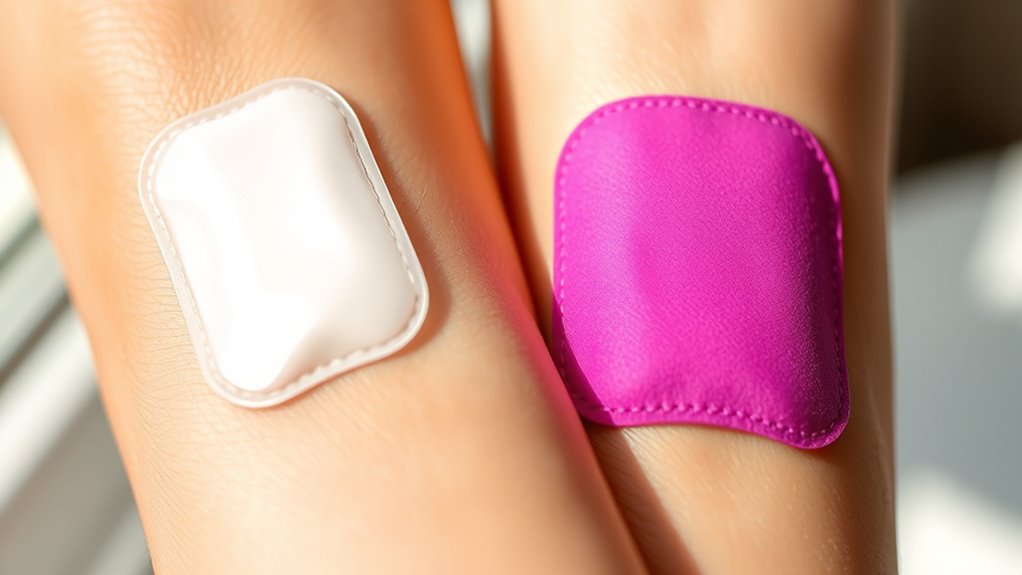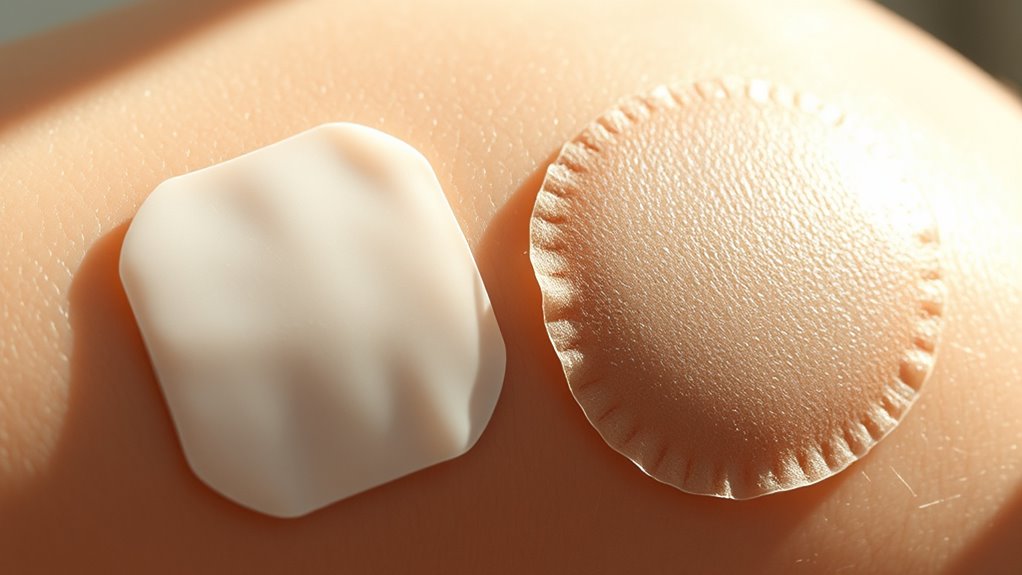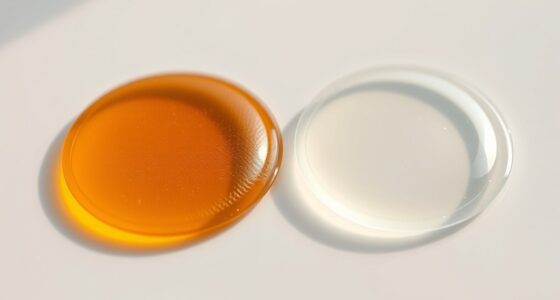Choosing between overnight and daytime patches depends on your symptom patterns, daily routine, and skin sensitivity. Daytime patches offer steady medication during active hours and are designed to handle daily activity and moisture. Overnight patches provide continuous relief during sleep, but may cause skin irritation if worn too long. Consider when your symptoms are worst and how the patches fit your schedule; if you want to explore more options, stay tuned.
Key Takeaways
- Select daytime patches for steady medication during active hours, and overnight patches for continuous relief during sleep.
- Consider skin sensitivity and irritation risk; shorter daytime wear may reduce skin reactions.
- Think about daily activity levels; daytime patches withstand moisture and movement better.
- Choose overnight patches for convenience with less frequent application, but ensure good adhesion overnight.
- Match patch timing to symptom patterns to optimize medication absorption and symptom control.

Choosing between overnight and daytime patches depends on your specific needs and schedule. If you’re trying to manage a condition with consistent medication delivery, understanding how each option affects medication absorption is essential. Daytime patches are designed to deliver medication steadily throughout your active hours, ensuring that the medication absorption aligns with your daily routines. This can be particularly helpful if your symptoms fluctuate during the day or if you prefer to have control over when the medication is most active. On the other hand, overnight patches are formulated to release medication over an extended period while you sleep. This can provide continuous relief during the night and early morning, which might be beneficial if your symptoms worsen at those times or if you find it difficult to remember to apply a patch during busy daytime hours.
One important factor to consider when choosing between these options is how your skin responds to the patch. Some people experience skin irritation from prolonged patch wear, especially if they have sensitive skin or if the patch ingredients cause a reaction. Overnight patches, which stay on longer, might increase the risk of skin irritation, especially if they are not changed regularly or if the skin isn’t properly cleaned before application. Conversely, daytime patches are typically worn for shorter periods, which can sometimes reduce the chance of skin irritation, but they need to be applied more frequently. This means you might have to be diligent about changing patches at specific times to maintain consistent medication levels.
Another aspect to think about is how the patch interacts with your daily activities. Daytime patches might be more practical if you’re active or sweating, as they’re often designed to withstand daily movement and moisture. Conversely, overnight patches need to adhere well during sleep, which can be challenging if you tend to move around or sweat during the night. Proper application and choosing the right adhesive can help minimize issues like detachment or skin irritation caused by movement or moisture.
Frequently Asked Questions
Can I Switch Between Overnight and Daytime Patches Easily?
You can switch between overnight and daytime patches easily, but pay attention to patch durability and adhesive comfort. Each type is designed for specific wear times, so swapping them might affect how well they stay on and how comfortable they feel. Make sure to follow manufacturer instructions for changing patches to avoid skin irritation or damage. If you’re unsure, consult your healthcare provider for personalized advice on switching patches safely.
Are There Specific Medications Better Suited for Overnight Patches?
Some medications are better suited for overnight patches because of their medication compatibility and patch longevity. You should consult your healthcare provider to determine if your medication works well with overnight patches, as certain drugs may require specific wear times for ideal effectiveness. They can advise you on whether an overnight patch will provide consistent medication delivery and maintain the right patch longevity, ensuring you get the best therapeutic benefit.
How Do Patch Adhesive Types Differ for Night Vs Day Use?
The adhesive types for night versus day patches differ mainly in adhesive strength and skin compatibility. Night patches often use gentler adhesives to prevent skin irritation during longer wear, while daytime patches have stronger adhesives to withstand daily activities. You should choose based on your skin’s sensitivity and the required adhesive strength, ensuring the patch stays secure without causing discomfort or damage upon removal.
What Are the Risks of Wearing Patches Longer Than Recommended?
Think of your skin as a delicate battleground. Wearing patches longer than recommended risks skin irritation and could lead to medication overdose if the medication absorbs too much. Prolonged use may cause redness, itching, or blistering, and increase the chance of too much drug entering your bloodstream. Always follow the label instructions to safeguard your skin and ensure safe, effective treatment—don’t push your luck or your skin’s boundaries.
Do Skin Types Affect the Choice Between Overnight and Daytime Patches?
Your skin sensitivities and patch compatibility play a role in choosing between overnight and daytime patches. If you have sensitive skin, you might prefer daytime patches that are designed for shorter wear, reducing irritation. Conversely, overnight patches can be beneficial if they’re compatible with your skin type and won’t cause discomfort during sleep. Always consider your skin’s unique reactions and consult your healthcare provider for the best option.
Conclusion
Choosing between overnight and daytime patches is like picking the right key to open your comfort. Whether you need steady support through the day or gentle relief while you sleep, your choice shapes your journey to wellness. Think of it as tuning a musical instrument—finding the perfect fit guarantees harmony. Trust your instincts, experiment a bit, and soon you’ll find the patch that becomes your trusted partner, turning your daily routine into a smooth, seamless melody.
Claire has a knack for turning complex dermatological concepts into engaging, easy-to-understand articles. Her work primarily focuses on creating detailed reviews and thought-provoking articles in the “Vetted” category. Claire’s writing not only informs but also inspires our community to try new skincare solutions.










